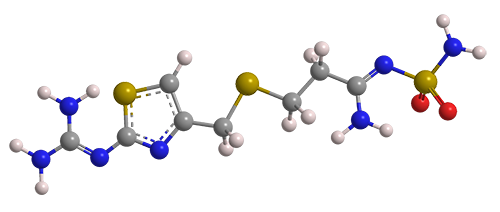What molecule am I?


Many of us suffer from gastric reflux, which manifests itself as a burning sensation known variously as heartburn, acid indigestion, and cardialgia. The preeminent treatment for this condition is famotidine, a drug developed in Japan and marketed since 1981 in the United States and elsewhere under the trade name Pepcid. The patents on famotidine expired in 2001, after which generic versions came onto the market.
Famotidine is a histamine H2 antagonist. It prevents histamine in the parietal cells of the stomach from secreting the acid that triggers heartburn.
This year, in their quest to identify existing drugs that might prevent or ease the effects of the COVID-19 virus, researchers noted that Chinese patients who took famotidine for heartburn had a higher rate of surviving the disease than those who used other heartburn medications. In April, physicians at Northwell Health hospitals in New York City and surrounding locations began to administer famotidine intravenously to critically ill patients. By the next month, the self-described Famotidine Research Team observed that patients treated with famotidine had half the risk of needing a ventilator—or dying—than untreated patients.
The researchers cautioned that these results could not be interpreted as a recommendation for using famotidine to ameliorate COVID-19 because many of the subjects were also on the now-discredited hydroxychloroquine regimen and because no cause-and-effect relationship between famotidine and the virus had been established. In late June, the Infectious Diseases Society of America recommended against the use of famotidine because of insufficient data at the time. The society repeated its recommendation in July.
Interestingly, a famotidine shortage that surfaced in the past few months cannot be completely attributed to physicians’ or COVID-19 patients’ attempts to use it against the virus. Recalls of the competing drug ranitidine have prompted its users to switch to famotidine.
Famotidine hazard information
| Hazard class* | Hazard statement |
|---|---|
| Not a hazardous substance or mixture |
*Globally Harmonized System of Classification and Labeling of Chemicals.
Famotidine fast facts
| CAS Reg. No. | 76824-35-6 |
| SciFinder nomenclature | Propanimid- amide, 3-[({2- [(aminoimino- methyl)amino]-4-thiazolyl}methyl)thio]-N-(aminosulfonyl)- |
| Empirical formula | C8H15N7O2S3 |
| Molar mass | 337.45 g/mol |
| Appearance | White to pale yellow crystals or powder |
| Melting point | 163–164 ºC |
| Water solubility | ≈1.0 g/L |
MOTW update
Estradiol was the Molecule of the Week for November 4, 2013. It is the major, and most potent, estrogen sex hormone in female vertebrates, especially mammals. In this year of the COVID-19 pandemic, the abundance of estradiol in women may be one reason that women have a lower risk of infection by—and death from—the virus. But so far the evidence is far from clear.

Learn more about this molecule from CAS, the most authoritative and comprehensive source for chemical information.
Molecule of the Week needs your suggestions!
If your favorite molecule is not in our archive, please send us a message. The molecule can be notable for its current or historical importance or for any quirky reason. Thank you!
Stay Ahead of the Chemistry Curve
Learn how ACS can help you stay ahead in the world of chemistry.

